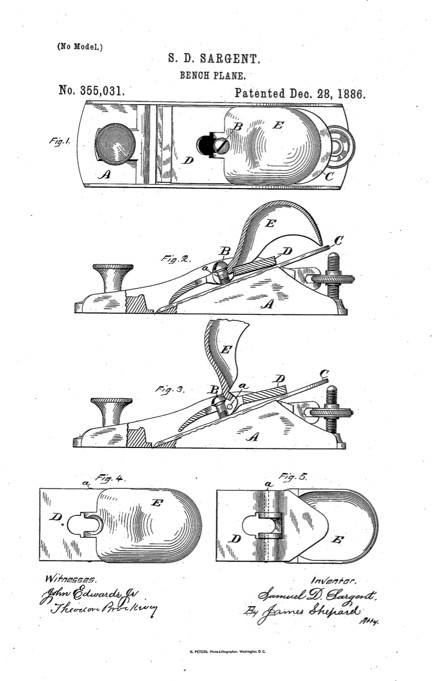The problems with the original knuckle lever were alleviated with a re-design. The design was presented in patent No. 1,053,270, granted on Feb.18, 1913, and became the standard knuckle lever-cap going forth. Interestingly, Stanley also submitted two other patents for knuckle levers caps, that were granted on the same day: patent No.1,053,274 and 1,053,356. A fourth patent, No. 1,069,669 was issued on August 12, 1913. None were ever implemented on a block plane. Here is a drawing of the knuckle lever-cap showing the improved cam lever mechanism under the lever cap.
The original simple two-piece lever cap was replaced with a four-piece lever cap. The lever cap is affixed to the plane via a “cap screw”, as in most other block planes. The cap screw is attached to a threaded boss projecting upwards from the “frog” of the plane. The two main components of the lever cap are the “base plate” and palm rest. The lower “base plate” has a forward edge which engages with the forward edge of the blade. The base plate is attached to the upper hollow convexed palm rest by means of a pivot pin. The image below are some schematics from the patent document, illustrating how the knuckles lever cap sits on the plane, and its two positions.

Fig. 2: A longitudinal section through a block plane showing the improved Stanley knuckle mechanism.
The portion of the base plate which continues under the palm rest has a key-hole slot, and towards the rear end is provided with a second slot through which the cam-lever mechanism extends. The locking mechanism for the lever cap is comprised of two parts. The first part is a lever which has a cam at the lower portion, and is shouldered at the upper end. This lever is attached via a pivot pin to the tail end of the base plate, and to a bearing bracket on the underside of the palm rest by means of a set of links secured by pivot pins.
With the blade situated in the optimal position, the base plate is seated over the head of the cap screw. With the enlarged portion of the key-hole slot positioned over the head of the cap screw, the lever is moved upwards to bring the cap screw into the narrow portion of the key-hole slot. At this point the palm rest is in the raised position (dashed lines in Fig.2 & 3). The palm rest is now moved downwards towards the blade. This movement of the palm rest will cause the locking mechanism to move the lower cam forward and into “frictional” contact with the blade. This action will cause the blade to be clamped in its seat.
One of the issues with the original design for the knuckle lever cap was the palm rest disengaging from the cap screw. The keyhole slot in this design prevents this from happening, however to prevent the cap loosening, there is a secondary mechanism. When the lever cap is locked into place, the palm rest moves its aperture over the head of the cap screw (see photo below), so that the sides of the palm rest form what the patent terms “an annular locking shoulder engaging the abutment formed by the head of the cap screw”. Here is a view of a “Sweetheart” version of the knuckle lever cap locked in place. With this design, there was no way for the lever cap to slip once locked.
The interesting thing about Patent No.1,053,270 is that it outlines more than one improvement for clamping mechanisms within the lever cap, however only one seems to have been implemented.




































